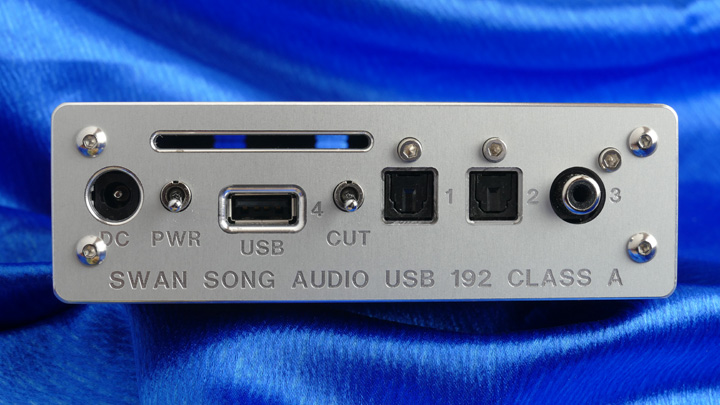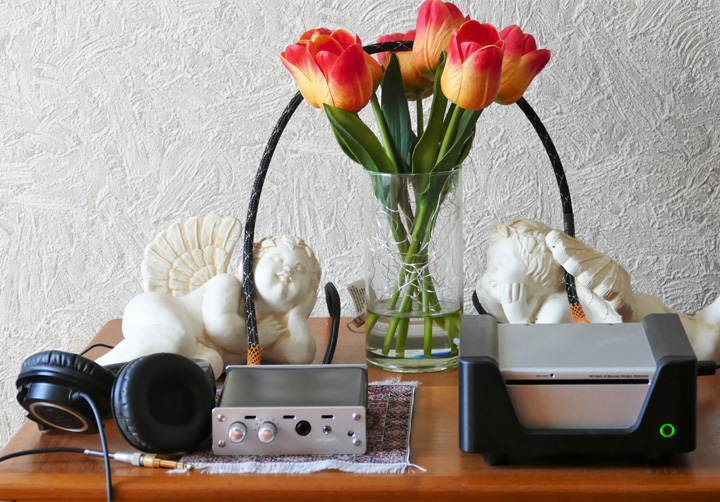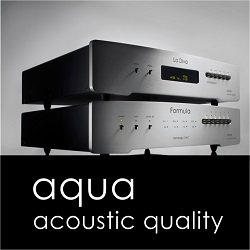
The Cygnet boasts an extensive choice of connectivity despite its small chassis, with coax, 2 optical and USB inputs. The coax and optical inputs handle up to 32-bit/192 kHz and the USB tops out at 24-bit/96 kHz. The DAC stage adopts the Texas Instruments PCM5142 and Cirrus Logic 8416 chips found in the higher tier White Swan series and adds additional power supply regulation, reclocking chip, and clock multiplier to utilize the upsampling feature. The defeatable upsampling can be selected by a toggle switch on the front panel and is useful in converting lower resolution files up to 24-bit/96 kHz. The DAC supports PCM but does not handle DSD or MQA. The Cygnet also borrows further from the White Swan, utilizing the same powerful Class A output stage, to give the unit ample muscle to drive headphone loads between 22 to 600 ohms, and adopts its formidable USB input filtering to supply multiple stages of discrete and active filtering, giving the USB stage legitimate audiophile credibility.
For the listening sessions, I threw three headphones in rotation with my Wyred Music Server/Streamer source to see how the Cygnet would handle them. First was a set of Cherry wood clad Audio-Technica ATH W1000 Sovereigns which have the unusual feature of angled drivers to simulate a loudspeaker listening perspective. The second was another stalwart from the Audio-Technica lineup, the ATH-M50, a professional workhorse. The third was the HiFiman 400i, a planar exotic that shone with the prior reviewed White Swan Song Class A headphone amp.

The headphone rotation showed a new favorite with this Swan Song offering. The Audio Technica M50 demonstrated professional pedigree, with subtlety, dynamic agility and deep, massive bass attack. The Sovereigns did a fine job on soundstaging with stupendous articulation in the upper octaves and although they have a propensity to sound bass shy with the wrong match, that situation did not arise here. The HiFiman which reigned top combination with the former White Swan traded a bit of slam and bass weight for a touch more refinement in the broad spectrum. All in all, a fine showing for the Cygnet with a variety of challenges.
The Cygnet showed a consistency of character through all of its different inputs, a definite plus for those whose source output will dictate available choice. The USB input delivered admirable sonics with a stock USB cable, but through Mr. Crocker’s custom silver USB cable with built in filtering, the quality rivaled the coax input, generally acknowledged top choice for DAC connectivity (short of the more exotic I2S.) While the cable does not ship stock with the Cygnet, it is a worthwhile $400 accessory found on the services page on the website.
The overall sound through all the configurations was quite smooth and emphatically refined. The weight was more midrange centric than the White Swan, achieving remarkable clarity to satisfy wide musical taste. It preserved the emotional expressiveness on vocal material like Tom Odell’s “Real Love” and separated it from a wall of guitar distortion on the grunge-worthy “All the Kids are Right“ by Local H. Highs were detailed and sweet, a Swan Song hallmark, and while not tubular in disposition, embodied the best attributes of well executed solid state. Bass was ample, but understated in comparison to the powerhouse weight evidenced by the next tier effort. The bass lines on popular cut “Royals” from Lorde’s Pure Heroine album, kicked out strong but a little less the White Swan pile driver, to subtly underpin the musical whole. Detail was nuanced, and transient precision had snap and excitement that kept the 24-bit/176.4 kHz cut “Dooji Wooji” from the HRx Reference Recordings Dick Hyman: From the Age of Swing lively and fresh. The fine layers of dynamic gradation were rich with information, especially in the critical soft end of the spectrum and the Swan Song amplifier proved adept at parading a nuanced performance that could swing to hard fortissimo on demanding passages.
Swan Song’s adoption of up-sampling is intended to largely bridge the gap between high resolution recordings and those of less than 24-bit/96 kHz resolution. You can think of it as the audio equivalent of up-converting a video signal to HD standard. I tested the switchable up-sampling to see its effect and was impressed to find that Mr. Crocker’s implementation made subtle rather than drastic changes when engaged, slightly increasing upper frequency energy and giving the illusion of more information on most recordings. The traditional penalties incurred by the use of up-sampling, namely blunting of transient attack and reduction in perceived bass energy were rendered minor and quite unobtrusive, a testament to proper design work. By not overplaying the effect, it becomes one of the more successful examples of the technique that I have come across, making its inclusion worthwhile.
So, how can I sum up my experience with the latest Cygnet product from Swan Song? The news is good all around. The tiny new Swan Song Cygnet Class A Headphone Amp/Upsampling DAC works, and works exceedingly well. It honors the stellar standards of superb engineering and craftsmanship embodied in the higher Black Swan and White Swan tiers, and shines like a gem. It’s a leather wrapped, tactile and musical pleasure whose miniscule proportions deliver quality sonics of breathtaking magnitude that should satisfy long term.
For more information, please visit www.swansongaudio.com


















